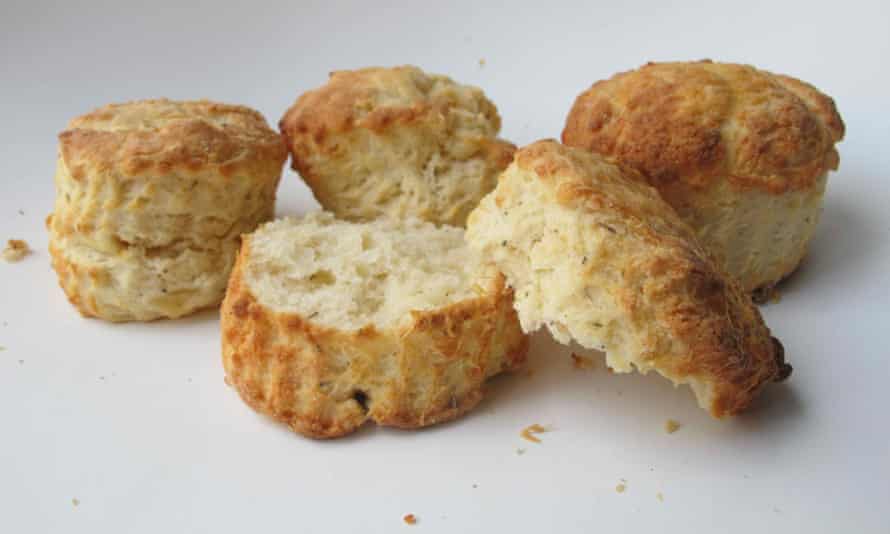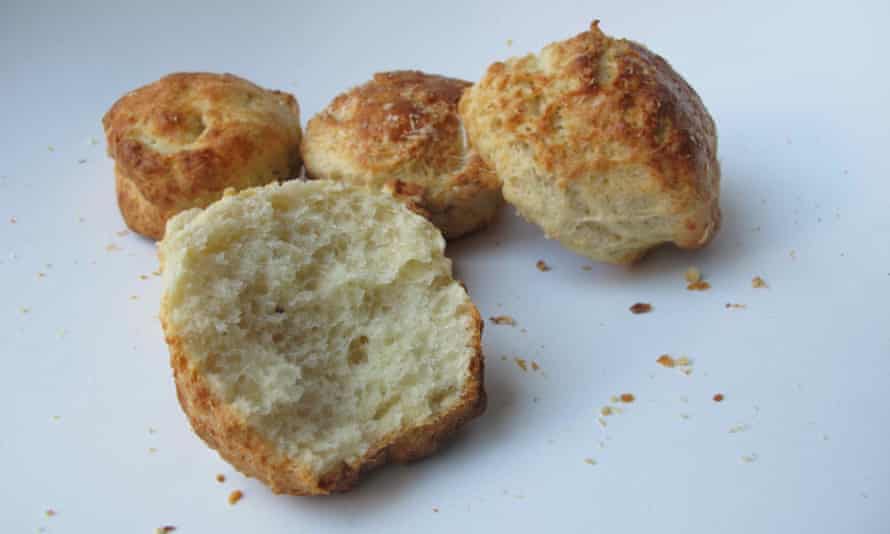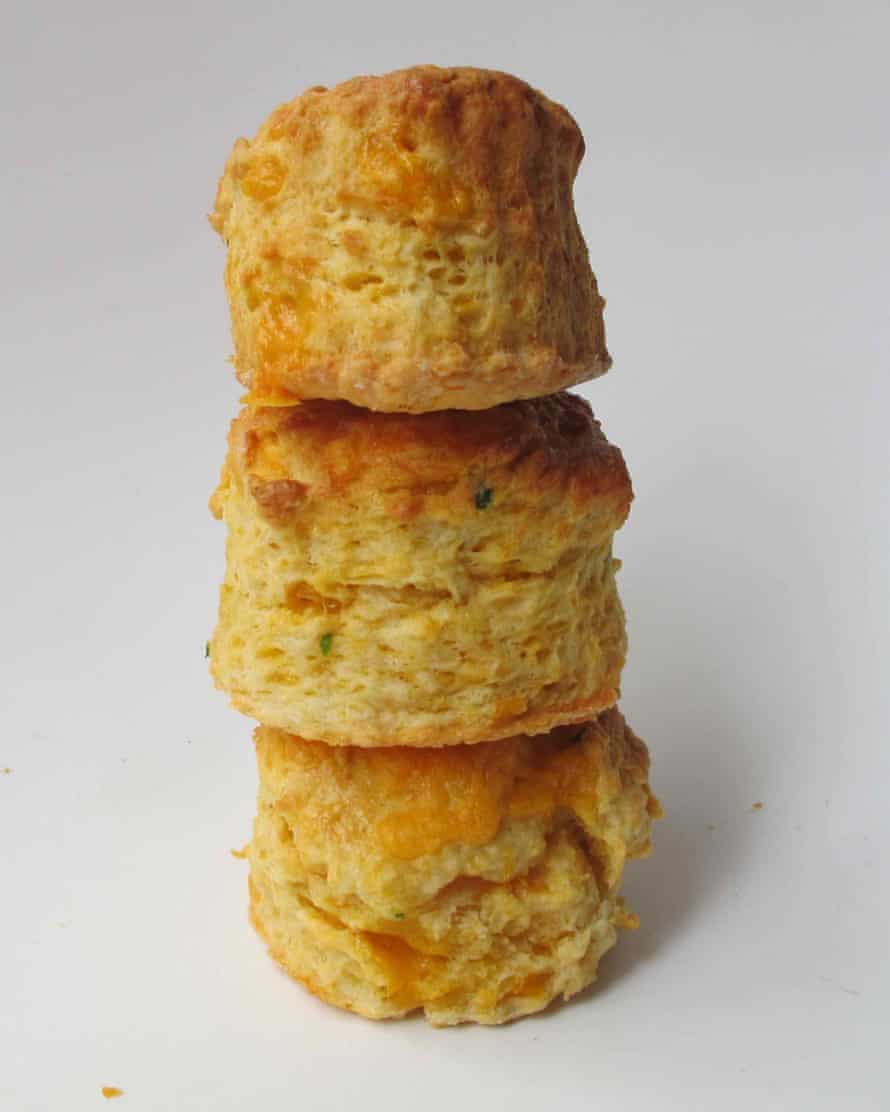What Do I Need to Make Cheese Scones
I love scones. I love the neat little ones you find on porcelain cake stands at places where they still take afternoon tea seriously, and I love tearing straight into a batch of sultana-studded numbers warm and fluffy from the oven. I love them with a fat garnet of raspberry jam, and I love them with cold butter and floral honey. But, most of all, I love a great golden billow of a savoury scone, topped with a decorous straw hat of toasted cheese. Indeed, my interest in historic houses can be almost solely attributed to the vast cheese scones on sale at every National Trust cafe.
In my not inconsiderable experience, however, you have to time your visit carefully to get them at their freshly baked best – whereas at home, you're always perfectly placed to pounce, making this a very dangerous recipe indeed. Sorry.
Flour and raising agent
Though this column is firmly against discrimination of any kind, there's no denying that the success of a scone can be largely determined with a ruler – they stand, or indeed fall, on their height, which means that most recipes I try use more than one raising agent, with only Delia Smith and the kitchens of Gwynedd's Penrhyn castle relying solely on self-raising flour. As said castle is in the care of the National Trust (the recipe coming from Jane Pettigrew's book Traditional Teatime Recipes from the Trust), and Smith is a woman I'd expect to know her way around a scone, I'm not unduly worried by this. However, Rox, daughter of Jo Holland, who has published her recipe on her own blog Notes from the Menu, uses extra baking powder, and baker Justin Gellatly makes his own from bicarbonate of soda and cream of tartar in his book Bread, Cake, Doughnut, Pudding.

But the ruler doesn't lie, and the best-risen by far come from Penrhyn; though scones do need a raising agent of some kind, it doesn't seem to be a case of the more the better here. Baking powder is all that's required – in the form of self-raising flour if you have some handy, or added to plain flour if not.
The fat
Butter is the fat of choice in all the cheese scone recipes I try, but its consistency varies, with Gellatly using it chilled, while Penrhyn Castle prefers it softened, and Bertie, the chef at the wonderfully named Scorch-O-Rama cafe in Scorching Bay, Wellington, New Zealand – who makes what one customer describes as "the best scones I've ever tasted" – melting it before use. Keeping the fat cool seems wise: it means it melts more slowly, creating little pockets in the dough as it rises, and giving the finished scone a flakier texture. Smith uses a fairly parsimonious amount, which strikes us as a crying shame in a teatime treat, though she is the only cook to add an egg instead. Personally, I'd prefer more butter, which makes the crumb softer and richer, while I suspect the protein in the egg might contribute to testers finding Smith's scones a wee bit tough (though this could also be the fact that they end up slightly overbaked, of which more later).

The liquid
Rox and Bertie bring their dough together with milk, while Penrhyn thriftily uses a mixture of milk and water, which gives the scones a lighter, breadier texture the testing panel conclude they rather like in a savoury variety. It also seems to make them slightly crisper on the outside; an unorthodox quality in a scone perhaps, but an undeniably popular one.
Smith and Gellatly both use buttermilk, the acid in which should help to give their scones a tender texture, but my testing panel can't tell the difference, while the tangy flavour is lost under the cheese. Simple milk and water seems the best bet here – Penrhyn's dough is softer and wetter than some of the others, and I credit this hydration for its impressive rise. More liquid turns into more steam in the oven – which in turn pushes the dough upwards and outwards.
Cheese
This, of course, is the really important bit – Smith reckons that "cheese scones were invented to use up the last remnants of some wonderful cheese", in her case cheshire, but almost anything hard enough to grate should work. Gellatly and Penryhn plump for strong cheddar, Rox for parmesan, and Bertie doesn't specify. Make it strong; testers find Smith's cheshire slightly underwhelming flavour-wise – if you have a milder cheese like this, you'll need to use more. If I'm buying something specially, rather than using up a lot of odds and ends from the fridge, I like a mature red leicester, as much for its bright orange colour as its lovely flavour.

Flavourings
Though cheese is pretty good on its own, as any aficionado of Welsh rarebit will testify, it's even better with mustard, particularly the fiery English variety favoured by Rox, Smith and Gellatly. The last adds further heat in the form of smoked, and hot, paprika while Bertie and Smith prefer cayenne pepper, but, nice as these all are with cheese, the panel come down in favour of mustard, which they think brings out its flavour better, rather than competing with it.
Smith also adds chives to her scones, and Penrhyn goes for mixed dried herbs. Chives are, of course, a natural pairing with cheese, and testers love them, though if you don't, feel free to leave them out. Gellatly is the only baker to add a little sugar to his savoury dough, which is lovely with paprika – but less good with mustard.
To finish
Scones always look handsome with a shiny top, an effect generally achieved with egg, as Gellatly suggests, or egg (or egg yolk) and milk, as Smith, Bertie and Rox recommend. A final sprinkling of cheese tops it off in an entirely satisfactory fashion; cheese scones ought to look like cheese scones. If in doubt, always add more cheese.
The method
Most scone recipes issue strict instructions on the matter of mixing, with Smith telling readers that "it's important not to overwork the dough or the scones will be heavy", so I'm with Rox's mother Jo, who expresses surprise at her method, which involves "smooshing" the dough to bring it together, as: "I'd always been led to believe that the less you handled scone dough, the better." Certainly Rox's are not at all tough, which may be down to the fact she rests the dough before baking. For maximum height, however, it's best to get the baking powder into the oven as soon as possible, as its efficacy decreases over time.

The shaping process is, according to many, similarly vital, with Smith, Rox and Penrhyn castle all cautioning bakers "to be very careful not to roll the dough out too thinly … the secret of well-risen scones is to start off with a thickness no less than an inch." This seems reasonable advice, unless you're after an English muffin.
Most scones go into a hot oven for about 10-15 minutes, which makes Bertie's lower, lengthier bake (40 minutes at 170C) unusual, though not as unusual as his baking tin method, which means his scones spread and merge into one another. They're very tasty indeed, but, with their vast amounts of cheese, and their damp, slightly squidgy texture, they're not much like a light and airy scone. Smith's, by contrast, seem overdone after 15 minutes at 220C, which might explain why they're rather dry in comparison with some of the others. Keep an eye on them – because the sooner they're done, the sooner you can tuck in.
Perfect cheese scones

(Makes about 12)
450g plain flour (or if using self-raising flour omit the baking powder)
6 tsp baking powder
1 tsp salt
1 tbsp English mustard powder (optional)
100g cold butter
250g strong hard cheese like mature red leicester or cheddar
2 tbsp finely chopped chives (optional)
120ml cold milk
120ml cold water
1 egg, beaten with a splash of milk
Heat the oven to 220C. Put the flour, baking powder, salt and mustard powder into a large mixing bowl and whisk together until smooth and well combined.
Grate in the butter, then rub it in with your fingertips until it looks like wet sand.
Finely grate in 225g cheese, add the chives, and then stir to combine. Mix in the milk and water until the dough just comes away from the edge of the bowl; don't handle it any more than is necessary. Tip on to a very lightly floured surface and flatten into a rectangle about 2.5cm high. Cut out with a fluted cutter (about 6cm wide for 12 scones), reshaping as necessary while handling the dough as little as possible.
Put on a baking tray and brush the egg and milk mixture. Grate the remaining cheese over the top and bake for about 12 minutes until golden. Allow to cool slightly on a rack before splitting open.
Warm cheese scones and cold butter – better even than the plain sort with clotted cream and jam, or do you have an even better recipe up your sleeve?
What Do I Need to Make Cheese Scones
Source: https://www.theguardian.com/lifeandstyle/wordofmouth/2016/oct/06/how-to-make-the-perfect-cheese-scones